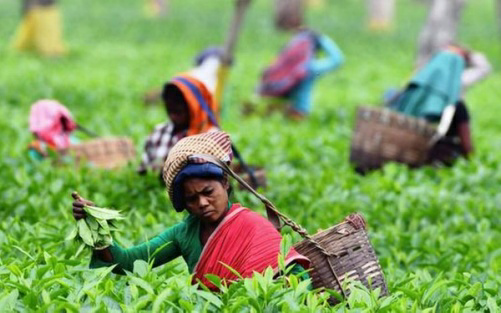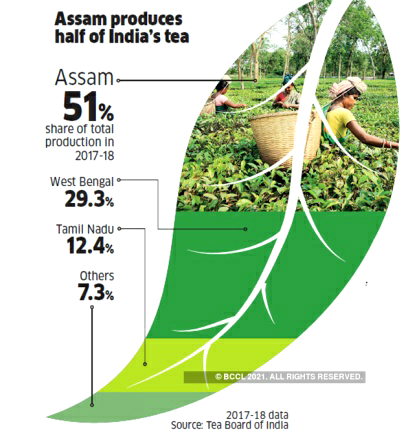Description

Disclaimer: Copyright infringement not intended.
Context
- Production of Darjeeling tea, one of the most popular tea varieties globally, has shrunk to 6.5 million kg in 2021, the lowest on record and just half of the 13 million kg produced two decades ago.
About
- Indian tea is among the finest in the world owing to strong geographical indications, heavy investment in tea processing units, continuous innovation, augmented product mix and strategic market expansion.
Major Tea growing regions
- The main tea-growing regions are in the Northeast (including Assam) and in north Bengal (Darjeeling district and the Dooars region).
- Dibrugarh is currently known as Tea City of India. The soil of the district is mostly fertile, alluvial soil.
- It is the gateway to the three tea-producing districts of Tinsukia, Dibrugarh, and Sivasagar.
- These three areas account for approximately 50% of India's Assam tea crop, and this gives Dibrugarh its rightly earned sobriquet as the "Tea City of India".
- The state of Assam is the world's single largest tea-growing region.
- Tea is also grown on a large scale in the Nilgiris in south India.
- India is one of the world’s largest consumers of tea, with about three-fourths of the country’s total produce consumed locally.

Market Size of Tea Industry in India
- In 2020, nearly 1.10 million tons of tea was consumed in the country.
- The market in the country is projected to witness a further growth in the forecast period of 2022-2027, growing at a CAGR of 4.2%. In 2026, the tea industry in India is expected to attain 1.40 million tons.
Challenges faced by the Tea Industry
Shutdowns of tea plantations
- There are many tea gardens which have closed down in recent years due to various problems affecting the industry.
- Some of these are Red Bank, Dharanipur, Dheklapara, Surendranagar and Bundapani of the Dooars and Raipur Tea estate in West Bengal.
- In Assam too, many tea estates have closed down or are operating just minimally.
Causes
Tea prices started declining
- Across the world, tea’s auction price has declined by almost 44% in real terms in the recent past as per World Bank’s report.
- In India, all the profits from the tea gardens were siphoned off and there was no real or proper reinvestment in improving quality of tea.
- The burgeoning growth of the small-holder sector (currently 50 per cent of Indian production of 1,390 million kg), consistent with their ability to produce teas at a lower cost, also added pressure to the price lines.
- These have resulted in closing down of the tea gardens.
Less Production
- Financial problems, power problems, labor issues, poor labor schemes, inadequate communication system, increased pollution fee, less subsidy for transport etc. have put the tea industry in North East India in a difficult situation, resulting in low production of tea and tea leaves.
Pest Problem
- Along with the mosquito bug, a disease called the bacterial black spot has also affected many plantations in North East Tea Estates.
Low wages for laborers
- As price realization of tea is very less in the international market and as temporary laborers are used in the peak seasons, usually the wages paid for tea industry laborers are very less.
- This made some of them starve and leave out the industry.
High production costs
- Low yields and High production costs are pulling the legs of Small Tea Growers backward.
- Even the corporate companies are slowly exiting out of the industry and were concentrating only on the retailing part instead of production.
Sick industry
- A considerable number of tea gardens have gone sick due to lack of infrastructure, modernization and efficient management.
No proper storage
- The problem of storing premium quality tea has always been there.
- Due to delay in transportation and lack of storage facilities, the processed tea gains moisture from the atmosphere and deteriorates in quality.
Climatic Conditions
- Unfavourable climatic conditions for tea plantations owing to scanty or very heavy rainfall have badly affected the tea industry.
Political turmoil
- In Darjeeling, due to political agitation, production of flag bearer variety of tea has suffered a lot.
- This has forced lot of exporters to substitute that with Nepal tea to compensate the flavor and aroma.
Health problems
- The poor living conditions make these labourers vulnerable to various diseases.
- The major health problems faced by the labourers are worm infestation, respiratory problems, diarrhoea, skin infections, filariasis and pulmonary tuberculosis.
No health benefits
- Under the Plantation Labour Act 1951, each tea garden should have a health centre with proper medical facilities.
- However, the gardens are remotely located and the health centres are located in distant towns.
- The workers do not have proper connectivity to these centres.
- There are no maternity benefit schemes available for the female tea garden workers.
- It has been found that women are engaged in hard jobs even during pregnancy and post natal period.
Wage/Price Movement
- The wage/price movement has been adverse.
- Taking 1995 as the base year, and measuring over a 24-year duration up to 2019, wages have gone up by eight times whereas tea prices have gone up only by 2 per cent. Consequently, many companies turned red.
Collapse of the captive Russian market
- South Indian plantations took an earlier and bigger hit because of the collapse of the captive Russian market.
Exit from captive production
- Branding and moving up the value chain were seen as a means to insulate oneself from the commodity price insecurity.
- But the integrated (forward and backward) tea companies soon figured out that captive production was a burden and exited, either fully or partially from captive production.
The recent shrinkage in Darjeeling Tea Production
- Climate change, closure of gardens, high level of absenteeism among tea workers, losing export markets due to agitation in the hills in 2017 and little effort to promote the Darjeeling tea in the domestic market have led to the fall.
- Planters fear that if the government does not come up with a revival package, then Darjeeling tea, the flagbearer of the Indian tea industry, will get lost in history just like the teas from Himachal Pradesh's Palampur.
Under the circumstances, the industry, in general, is in crying need to have a structural change in the way it operates.
Suggestions
Need for Organized Business
- Indian tea industry is still unorganized and even though Government is controlling this industry with Tea Board, it’s not that effective as expected.
- Thus, it is the Tea Board that has to undergo structural reforms in order to safeguard the industry as well as so many people who is dependent totally on tea for their survival.
Quality Enhancement
- Only quality tea production paves the way to preserve and significantly increase the export prices.
- Moreover this also will increase the demand for Indian tea among international products in the global arena and thereby increasing the profit margins as well as improving the living standards of people who are dependent on tea industry.
Awareness Programs
- Growing Small Tea Growers become a biggest challenge for the Tea Industry that only production is given importance by them because of ignorance.
- Thus, to improve the standards of Tea Production, Government and Tea board have to organize more awareness programs on Tea plantations and on entrepreneurship skills, so as to run the business with better profits.
Distribute Land-Ownership
- One way of ensuring a holistic sustainability of the plantation industry is to distribute land-ownership in favour of the plantation employees and buy back the raw material through a co-operative outfit.
Price Formula
- The green leaf purchase can be based on a price-formula linked to, the published industry auction price.
- Individual corporates may want to pay a higher price, based on their end price realization.
- In consideration of transfer of land ownership, it should be made obligatory for ex-employees to sell the raw materials to the corporate which has the infrastructure and technology for processing the primary produce, adding value as appropriate and marketing the same.
Land disinvestment
- The land disinvestment should also be viewed in the light of the increasing uncertainty over land ownership both due to ‘land title’ issues, as well as political, social and economic pressure for land ownership.
- The value of a plantation, be it in terms of Rs/kg of production or Rs/hectare of plantation should simply be based on operational profits.
Social and Welfare amenities
- Once the workmen become owners of land and cease to be plantation employees, it will be incumbent on the government to provide them with social and welfare amenities, currently provided by the plantation managements, through their various existing schemes.
- This will further bring down production costs for the corporates.
- The government can thus ensure complete social and welfare care for this populace.
- Such a proposal could also be used to negotiate a trade-off with the government, with respect to use of a certain percentage of land for independent-use by the corporate, without any strictures from the government in terms of its use (this freedom currently is not available to plantation companies).
- Thus, the corporates would insulate themselves from the wage increase cycle and their raw material cost would get linked to their end price realisation.
- The onus of improved conditions of the workmen would shift to the government, for which various schemes already exist.
- The workmen, on the other hand, will have the social and financial security net of owning land, with an assured buyback arrangement for the crop.
Conclusion
- India being the second largest producer of Tea has numerous opportunities to develop the Tea Industry as it is providing employment to a huge number of people in the north eastern states.
- A win-win for all and therefore a truly sustainable and transparent model — is the key requirement for a highly labour-centric industry like tea plantations.
https://economictimes.indiatimes.com/news/economy/agriculture/darjeeling-tea-output-sinks-to-record-low-in-2021/articleshow/88674049.cms












